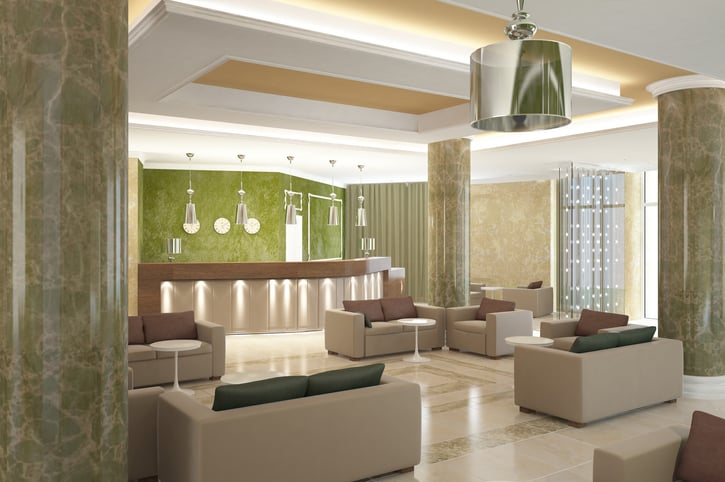
Step into any hotel, and you might notice a subtle yet noticeable change in lighting.
While it may not be immediately obvious, the shift from traditional incandescent light bulbs to LED (light-emitting diodes) lighting is transforming how we illuminate our spaces.
Hotel LED lighting has become the new standard, offering the same warm glow as incandescent bulbs but with added energy efficiency. This transition not only helps reduce utility costs for hotel furnishings, fixtures and equipment (FF&E) but also allows for seamless integration into different spaces.
With LED lighting integrated into casegoods, hotels can provide optimal lighting where guests need it most, improving their overall stay.
Hotel LED Lighting - Costs = A Bright Idea for Your Bottom Line
There was a time when LED lights weren’t considered a worthwhile investment.
In the early 2010s, LED technology was still in its infancy, with prices significantly higher than traditional incandescent and fluorescent bulbs. Moreover, energy-efficient spiral compact fluorescent lights (CFLs) were gaining popularity, making LED bulbs seem like an expensive gamble.
The initial payback period for LED lights was lengthy, often taking over three years to recoup the investment through energy savings. This was especially tough for hotels, where long-term savings are important but quick changes can be a hassle.
But times have changed.
Today, due to technological advancements, LED lights offer a much shorter payback period, often less than six months. This, coupled with a significant decline in LED prices due to mass adoption, has made them a highly cost-effective lighting solution.
For hotel owners, designers, and purchasers, this shift means a viable and economical option for lighting their FF&E. By embracing LED technology, they can not only reduce their energy consumption and operational costs but also contribute to a more sustainable future.
How LED Lights Improve Hotel FF&E Cost Savings
Compared to traditional lighting sources often used in hotel FF&E, LEDs outshine their competition on several fronts, including:
-
Energy efficiency & longevity
-
Versatility
-
Reducing environmental impact
1. Energy Efficiency & Longevity
LEDs are significantly more energy-efficient and long-lasting than traditional incandescent and fluorescent lighting. In fact, an LED uses up to 80% less energy to produce the same amount of light compared to an incandescent bulb. This translates to substantial energy savings for both residential and commercial users.
To go along with energy efficiency, LEDs are also known for their exceptional longevity. While incandescent bulbs typically last between 1,000 and 2,000 hours, LEDs can last anywhere from 25,000 to 50,000 hours or even longer. This means that LEDs can last for years without needing to be replaced, reducing maintenance costs and the environmental impact associated with frequent bulb replacements.
2. Versatility
Unlike incandescent bulbs, which produce a warm, yellowish light, LEDs can emit a wide range of colors and tones, including white light that is virtually indistinguishable from the light emitted by incandescent bulbs.
This versatility allows LEDs to be seamlessly integrated into existing lighting fixtures and designs.For example, older-style lamps or chandeliers can be retrofitted with LED bulbs without compromising their aesthetic appeal.
3. Reducing Environmental Impact
LED lighting is a vital component of building a sustainable and environmentally friendly profile.
As consumers become increasingly aware of the importance of reducing their carbon footprint, hotels are under pressure to adopt eco-friendly practices. By implementing LED lighting, hotels can demonstrate their commitment to sustainability and attract environmentally conscious guests. This translates to lower greenhouse gas emissions and a reduced environmental impact.
Hotels can also highlight their energy-efficient lighting practices in their marketing materials and sustainability reports, showcasing their commitment to green initiatives.
Incorporating Hotel LED Lights Into FF&E
Where are LED lights a good fit in hotels and their FF&E?
Virtually everywhere a hotel uses lighting, indoors and out. Ballrooms and bathrooms, lobbies and common areas, desks, cabinets and wardrobes, and even headboards are all candidates for LED lights.
Not only do LEDs help reduce electricity bills, but they also help an interior designer combine ambiance with utility:
-
Adjustable room lighting to satisfy a guest’s every whim. Guests can alter LED light furniture’s color and intensity with a link to their tablet.
-
Lighting that combines with architecture to create the most appealing, even artistic environment.
-
Light bulbs that function in fixtures made from all types of materials.
-
Alarm clocks that wake guests with changing light levels instead of that grating buzzer.
-
Better security with well-lit halls, garages, and outdoor areas.
LEDs’ flexibility allows lighting to adapt to different preferences and requirements quickly and easily. Guests can find the right level and color of light for work, relaxation, and sleep with a simple adjustment.
What are the Drawbacks to Hotel LEDs?
Like any product, LEDs do have a shortfall.
When considering LEDs for your hotel, one thing that’s important to remember is that most hospitality FF&E companies can only install plug-in LEDs. They can’t hardwire lighting. You’ll need to work with a hospitality FF&E supplier that has the right installation capabilities to make your design happen.
Frequently Asked Questions about Hotel LED LightingHere are some of the most frequently asked questions about hotel LED lighting: How Do LED Lights Impact Guest Comfort And Satisfaction?LED lights can significantly enhance guest comfort by allowing for customizable lighting options in hotel rooms. Many establishments now use adjustable LEDs, enabling guests to easily change the brightness or color to fit their mood—whether they want a cozy atmosphere for relaxation or brighter light for work. This flexibility contributes to a more enjoyable stay, as guests can create the ideal environment for their needs. LEDs can also mimic natural light, which can improve overall comfort and well-being during their visit. What Specific Maintenance Or Operational Considerations Come With Using LED Lights In Hotels?While LED lights are generally low-maintenance due to their long lifespan, there are still some considerations for hotel operators. Regular cleaning of the fixtures is important to maintain brightness, especially in high-traffic areas where dust can accumulate. It’s also a good idea to periodically check the wiring and connections to ensure everything is functioning correctly. If the lighting system is integrated with smart controls, occasional software updates or troubleshooting might be needed. Overall, the maintenance requirements are minimal compared to traditional lighting, making LEDs a practical choice. How Does The Lifespan Of LED Lights Compare In High-Traffic Areas Of Hotels Versus Less-Used Spaces?LED lights are known for their impressive lifespan, typically lasting between 25,000 and 50,000 hours. However, in high-traffic areas like lobbies or hallways, their lifespan may be slightly reduced due to increased usage and potential dust buildup. That said, LEDs are designed to handle frequent switching on and off, which means they perform well even in busy environments. While you might see a bit of wear in high-traffic spots or spots were they are on longer than others, they still far outlast traditional bulbs, making them a solid choice for areas that see a lot of activity. |
LED Lighting Transforms Hotels
LED lighting has revolutionized the hospitality industry, offering a trifecta of benefits: cost savings, improved guest experience, and environmental sustainability. With up to 80% less energy consumption and lifespans of 25,000 to 50,000 hours, LEDs significantly reduce operational costs and maintenance needs.
As prices continue to fall and technology advances, LED adoption in hotels is no longer a luxury but a necessity.
For hotel owners and designers, embracing LED technology represents a smart investment that pays off in reduced expenses, increased guest comfort, and a smaller carbon footprint. The future of hotel lighting is undoubtedly LED-bright.
Value Engineering for FF&E Cost Savings
Designing hotel casegoods that meet your needs and FF&E budget is easy with value engineering. Set up your free value engineering consultation today:
This article was originally published in 2018 and was recently updated to reflect industry trends.

